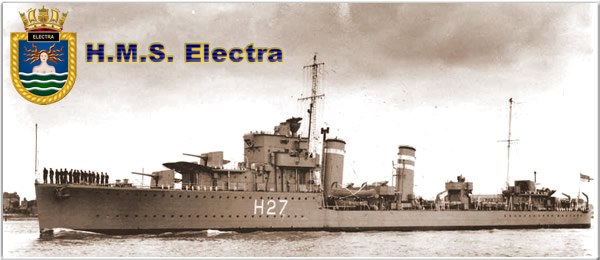 Saturday 24th may 1941. Empire Day. I had only just begun when I came on duty for the middle watch onboard the destroyer "Electra." We were in the North Atlantic, escorting H.M.S. Hood and H.M.S Prince of Wales.
Saturday 24th may 1941. Empire Day. I had only just begun when I came on duty for the middle watch onboard the destroyer "Electra." We were in the North Atlantic, escorting H.M.S. Hood and H.M.S Prince of Wales.
This day was to become the blackest day in naval history. H.M.S. Hood, the largest battle cruiser in the world, reputed to be unsinkable, was flying the flag of Rear-Admiral Holland¹ and we were out after the German battleship "Bismarck" and her escort the cruiser "Prinz Eugen" who were trying to break through our blockade and on to the convoy routes.
The weather was cold and a very heavy sea was running. Blue signal lights started to wink between the ships and we knew something was up because the vibration of the ship increased as we picked up speed.
Like all sailors, we were eager to hear the latest buzz, and it was not long before we got it. The Bismarck had been reported in our area. The course was altered and we found ourselves head on into the weather and great waves crashed over us as we ploughed our way along at 28 knots.
The ship's Tannoy system crackled into life. "Do you hear there!" "Hands will go to action stations at 0330 hours. Anti-flash gear to be worn. Contact with the enemy expected 0600 hours in the morning." A buzz of excitement went round the machine gun deck where I was on duty. One lad remarked "This is it and it's a good job we have got two of the big boys with us." We knew our job would be to go after the Prinz Eugen while the Hood and Prince of Wales attacked the Bismarck. We were full of confidence and we would soon see them off.
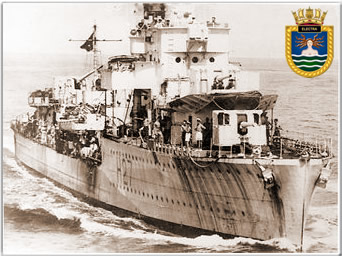 The great waves crashed against us and, with a mighty roar, the water tore along our decks. Somewhere on our starboard quarter, in the darkness, were our two great charges straining forward as we were in this very heavy sea.
The great waves crashed against us and, with a mighty roar, the water tore along our decks. Somewhere on our starboard quarter, in the darkness, were our two great charges straining forward as we were in this very heavy sea.
There were eight of us on the machine gun platform and every hour it was the duty of two of us to relieve the bridge look outs. My turn came at 0300, when the Leading Seaman in charge said, "OK, Buck Boy, your trick." So up I went, groping my way along. A big wave broke over the ship as I got to the break of the fo'c'sle and I got soaked.
Finally, I reached the lookout position on the starboard side. I sang out "Starboard lookout relieved, Sir!" and a muffled reply came from the bridge, "Very good."
I scanned the water around us and the first streaks of dawn were approaching away on the horizon. Visibility was not too good and I could just make out the Hood on our quarter - her great bows dipping under, then rising, lifting tons of water high in the air which went in cascades back along her decks.
0325 hours, the Captain, Commander May, turned to the bridge messenger and said "Go down to the Wardroom and tell my officers that there will be blood for breakfast this morning."
0330 hours - "Action stations!" Men tumbled out from below decks, I was relieved by the action lookout and away down to "X" gun, of which I was a crew member. The gun was cleared away, tampions were taken out of gun muzzles, control phones and sights were checked, director pointers and gun pointers were lined up.
Our armaments consisted of four 4.7 inch guns and eight torpedo tubes. The tubes were set in fours. We had four trained to starboard and the other four to port. Our Captain had always had visions of torpedoing a capital ship of the enemy and now was his chance. Owing to our high speed and very heavy seas our two sea boats, which consisted of two whalers, were smashed on their davits. The guard rails were bent and twisted, vent covers torn and flapping in the wind. Dawn was coming up fast and we could see the rest of the ships. The other three destroyers, like us, were making heavy weather of it. One moment you saw them, the next moment they had disappeared completely.
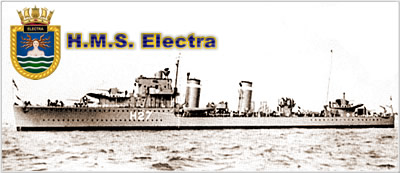
0400 hours: by this time we were taking a terrific beating by the sea. How much could this little ship take in a sea like this?
We were all huddled round the gun trying to keep out of the wind and spray, when one of the lads remarked, "There goes the Battle Ensign!" and the largest White Ensign in the ship was hauled up to the top of the foremast. We looked around at the other ships and could now clearly see their Ensigns streaming our proudly behind them. It gave one a feeling of pride. The excitement of the coming battle had now died down and tension took its place - everyone wondering what the next few hours would bring.
Captain D - in charge of destroyers - had requested permission to ease down as the destroyers were taking a pounding from the sea and a lot of damage was being done. Permission was granted and the Admiral signalled "Am going ahead - catch up as soon as possible." And we eased down to a more comfortable speed. The two great ships disappeared into a squall ahead of us.
Our ship was now riding these enormous waves instead of crashing through them. Cookie managed to light the stove and, before long, hot tea and sandwiches were brought round to everybody.
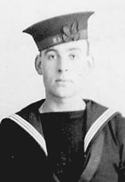
Jack as a young matelot
The sea abated a little but we had now run into sleet and mist squalls but gallantly the little ship ploughed forward. We were now in the contact area - every man keeping a good look out in case the Bismarck should turn and head back. Tension and fear was on every man's face. We were a small ship. Alone, without the protection of Hood's big guns, for she was now some twenty minutes or half and hour ahead of us. "Listen!" What was that faint rumbling up ahead? Or was it the sea? No one knows. Approx 0600: great activity going on up on the bridge. Suddenly the Bosun came along. We heard the shill of the Bosun's pipe and then the order "Starboard Watch, Stand to!" "Port Watch, make ready to pick up survivors!" The contents of the last signal received flashed round the ship like wildfire. This was it: "Hood sunk am taking immediate action. From Prince of Wales."
The truth slowly dawned on us as we made ready to pick up hundreds of injured and wounded men from the grey cold sea. We could not turn out our boats as they were smashed, hanging in the davits. Blankets, medical supplies, hot beverages and rum were got ready. Scrambling nets were flung over the ship's side, trailing into the water. Men were lining the side ready with hand lines, eyes straining into the greyness ahead.
It was only what seemed like a matter of minutes when we broke out of a mist patch into the clear. And there it was. The place where the Hood had sunk. Wreckage of all descriptions was floating on the surface. Hammocks, broken rafts, boots, clothes, caps. Of the hundreds of men we expected to see there was no sign. An awestruck moment and a shipmate next to me exclaimed "Good Lord, she's gone with all hands."
We nosed our way slowly amongst all the pitiful remains of books, letters, photos, and other personal effects floating by and a shout went up as a man appeared clinging to a piece of flotsam a little further away. Two more were seen - one swimming, the other appeared to be on a small float.
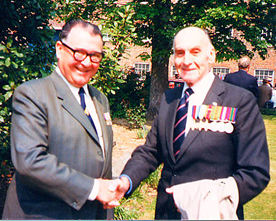
1987: Jack (right) and the man he rescued- Ted Briggs.
I went down the scrambling net with several other men and the water was around our knees. We hung onto the net, our arms outstretched as the first man floated alongside. Quickly we grabbed him and lifted him onto the net. Careful hands on deck reached down and hauled him up to the deck. He was wrapped in a blanket and taken forward onto the Mess deck, our ship's Doctor and sick berth attendants taking care of him.
Another man had been brought in further along the ship's side and a line had been passed to the third one and he was hauled to the side and brought aboard.
We searched for a long time among what remained of this once proud ship but there was no one. Not even a body. Out of 1,400 men on the ship 1,397² of them went down with her. The only three to survive were a Midshipman, an Able Seaman and a Signalman.
With a heavy heart we turned away as we could do no more.
We made all speed back to Reykjavik in Iceland where we landed our only three survivors of H.M.S. Hood. Whilst in Reykjavik harbour we saw the Prince of Wales come in and her damaged superstructure could be clearly seen where shells from the Bismarck had caught her. Throughout Sunday 25th May and Monday 26th May units gave chase to the Bismarck and on Tuesday 27th May 1941 the Bismarck, pride of the German navy, was sunk by the Nelson³, Rodney and KGV. She went down fighting to the last.
Edward J Taylor
Aged 40 years, 9 months
¹ Actually Vice-Admiral Holland
² Actually 1,415 were lost
³ HMS Nelson was not present...the main heavy combatants were Rodney and KGV